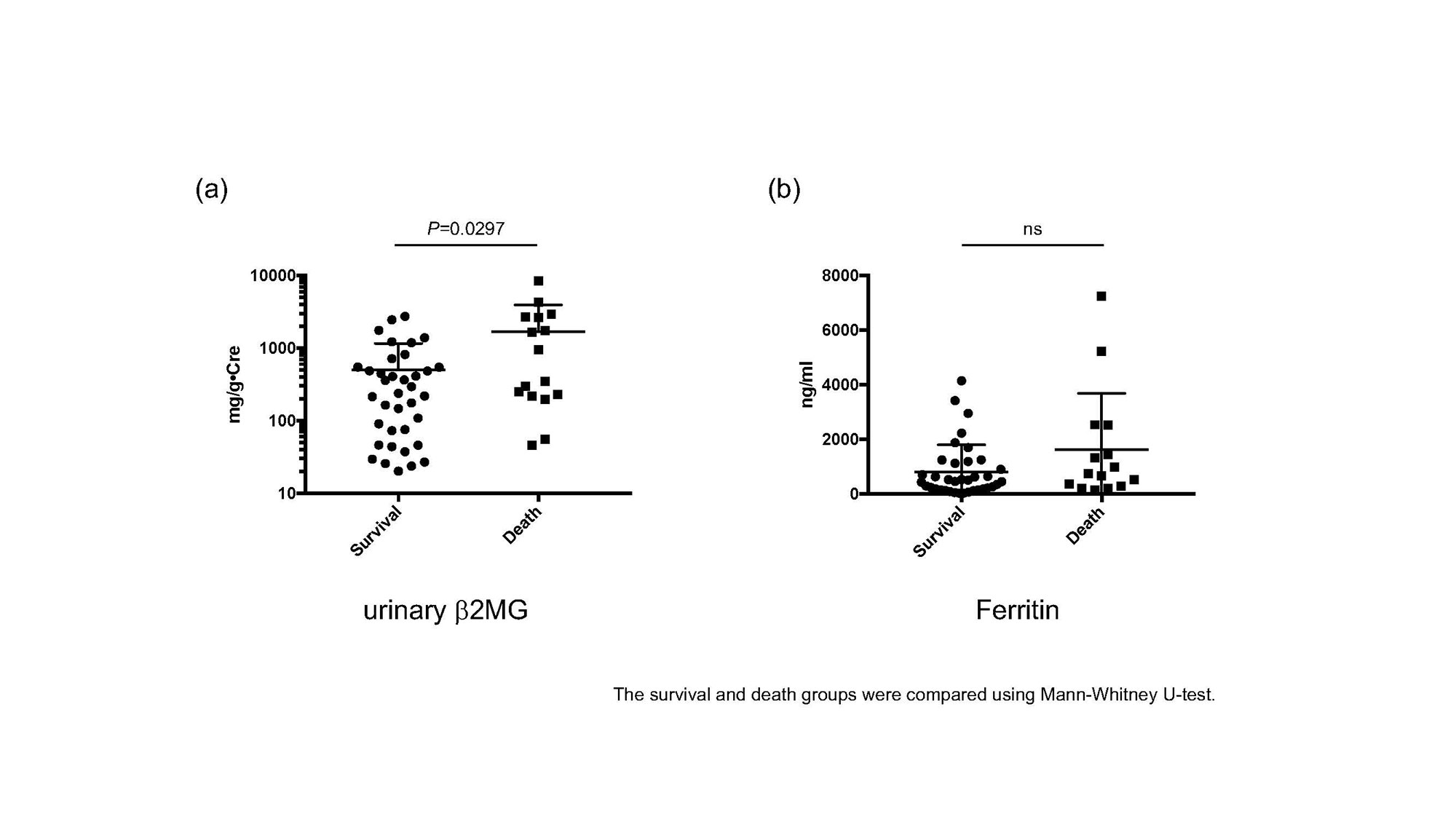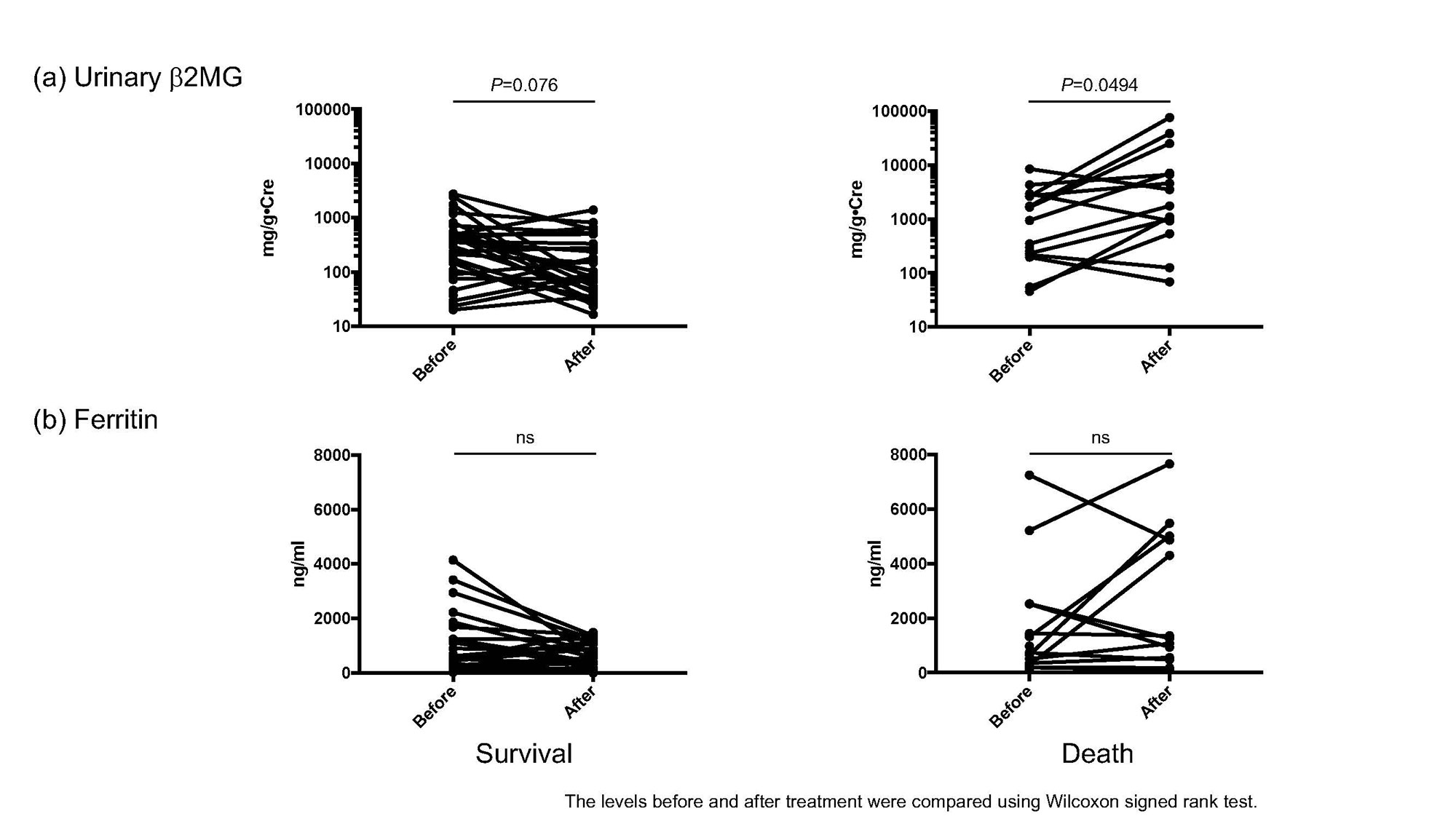Session Information
Session Type: Poster Session D
Session Time: 1:00PM-3:00PM
Background/Purpose: Interstitial Lung Disease (ILD) accompanied with anti-melanoma differentiation-associated gene 5 (MDA5) antibody-positive dermatomyositis (DM) is usually rapidly progressive and life-threatening with poor prognosis. Although serum ferritin has been reported as a prognostic marker for ILD among patients with anti-MDA5 antibody positive DM, serum ferritin levels does not necessarily correlate with disease activity of ILD in some patients. Beta-2 microglobulin (β2MG) is a light chain molecule of the MHC-class I, and urinary β2MG is often used as a marker for tubular damage in kidney. It is also known to be elevated in malignant tumors, infectious diseases, and autoimmune diseases such as juvenile idiopathic arthritis. In this study, we assessed the utility of urinary β2MG as a disease activity marker or a prognostic marker in anti-MDA5 antibody-positive DM with ILD.
Methods: This retrospective study included patients with anti-MDA5 antibody-positive DM who admitted to our division from January 2004 to March 2022. Data of Urinary β2MG and serum ferritin were measured before treatment, and these were serially examined during induction treatment. The values were used that obtained within 200 days after the hospitalization.
Results: The median age of the patient was 51 (range, 20-85years), and numbers of women was 35 (66%).Of the 55 patients with anti-MDA5 positive patients, 53 patients were tested for urinary β2MG at the time of diagnosis. Thirty-three patients (70%) survived and 16 (30%) died during induction treatment. The treatment included glucocorticoid, cyclosporin, tacrolimus, intravenous cyclophosphamide, methotrexate, azathioprine, infliximab, baricitinib and plasmapheresis. The median age of the patients did not differ between patients who survived and those who died (50 and 53.5 yrs old, respectively). Urinary β2MG levels before treatment were significantly lower in the survived patients than those in the dead patients (499 and 1698 mg/gCr, respectively, p=0.025, Fig. 1(a)). Serum creatine and KL-6 did not differ between the groups (0.62 and 0.55 mg/dl, 756 and 887.6 U/ml, respectively). Urinary β2MG significantly decreased in the survived patients, while it increased in the dead patients despite intensive treatments (Fig. 2(a)). In contrast, there was no difference in serum ferritin levels before treatment between patients who survived and those who died (806 and 1622 ng/ml, respectively, p=0.09, Fig 1(b)). Serum ferritin levels did not statistically decrease by treatment in both groups (Fig 2(b)).
Conclusion: Elevated urinary β2MG level is a poor prognostic marker in patients with anti-MDA5 antibody-positive DM who have ILD. Furthermore, increase of urinary β2MG after treatment indicates resistance to treatment and fatal outcome.
To cite this abstract in AMA style:
Nakamura J, Nagashima T, Sato K. Urinary Beta-2 Microglobulin Is a Sensitive Prognostic Marker in Dermatomyositis Patients with Interstitial Lung Disease Positive for Anti-MDA-5 Antibody [abstract]. Arthritis Rheumatol. 2022; 74 (suppl 9). https://acrabstracts.org/abstract/urinary-beta-2-microglobulin-is-a-sensitive-prognostic-marker-in-dermatomyositis-patients-with-interstitial-lung-disease-positive-for-anti-mda-5-antibody/. Accessed .« Back to ACR Convergence 2022
ACR Meeting Abstracts - https://acrabstracts.org/abstract/urinary-beta-2-microglobulin-is-a-sensitive-prognostic-marker-in-dermatomyositis-patients-with-interstitial-lung-disease-positive-for-anti-mda-5-antibody/


